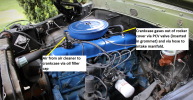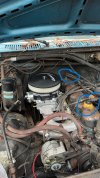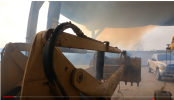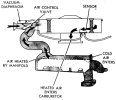Matthew K
Line Up and Wait
Hi All-
Have what seems to be a perplexing issue. I replaced the intake and exhaust manifolds on my f100's ford 300 and upgraded to a four barrel carb (single barrel before ). I seem to be having a never ending vacuum leak. I started with installing a 1 inch spacer, gasket on each side, noticeable vacuum leak. After checking everything, I replace the gaskets in case the spacer's included gaskets were junk. After replacing, the leak seemed to go away for about ~30 seconds, and then resurfaced, albeit its not as bad as before as I have more idle screw control now. Is it possible I'm doing something wrong with the gaskets?? Seems like a trivial task. The perplexing thing to me is the vacuum leak seemed to be gone at first after replacing.
). I seem to be having a never ending vacuum leak. I started with installing a 1 inch spacer, gasket on each side, noticeable vacuum leak. After checking everything, I replace the gaskets in case the spacer's included gaskets were junk. After replacing, the leak seemed to go away for about ~30 seconds, and then resurfaced, albeit its not as bad as before as I have more idle screw control now. Is it possible I'm doing something wrong with the gaskets?? Seems like a trivial task. The perplexing thing to me is the vacuum leak seemed to be gone at first after replacing.
Admittedly this is my first time swapping carbs on something that's not a lawn mower/atv, so it's possible I've missed something.
Thanks all
Have what seems to be a perplexing issue. I replaced the intake and exhaust manifolds on my f100's ford 300 and upgraded to a four barrel carb (single barrel before
 ). I seem to be having a never ending vacuum leak. I started with installing a 1 inch spacer, gasket on each side, noticeable vacuum leak. After checking everything, I replace the gaskets in case the spacer's included gaskets were junk. After replacing, the leak seemed to go away for about ~30 seconds, and then resurfaced, albeit its not as bad as before as I have more idle screw control now. Is it possible I'm doing something wrong with the gaskets?? Seems like a trivial task. The perplexing thing to me is the vacuum leak seemed to be gone at first after replacing.
). I seem to be having a never ending vacuum leak. I started with installing a 1 inch spacer, gasket on each side, noticeable vacuum leak. After checking everything, I replace the gaskets in case the spacer's included gaskets were junk. After replacing, the leak seemed to go away for about ~30 seconds, and then resurfaced, albeit its not as bad as before as I have more idle screw control now. Is it possible I'm doing something wrong with the gaskets?? Seems like a trivial task. The perplexing thing to me is the vacuum leak seemed to be gone at first after replacing.Admittedly this is my first time swapping carbs on something that's not a lawn mower/atv, so it's possible I've missed something.
Thanks all




